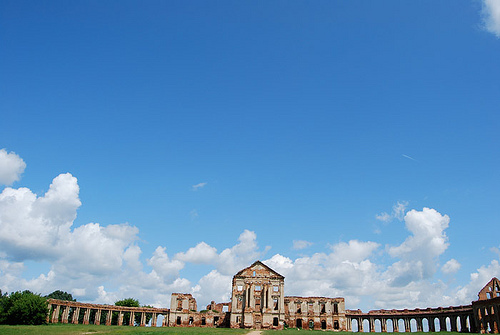

Location: Ruzhany village, Brest Oblast Map
Constructed: 1770s by Aleksander Michał Sapieha
Ruzhany Palace (Belarusian: Палац у Ружанах), also known as the Ruzhany Palace Complex of the Sapieha Family or Ruzhany Castle, is a prominent historical and architectural monument located in the town of Ruzhany, Pruzhany District, Brest Region, western Belarus. Often dubbed the "Belarusian Versailles" for its grandeur and stylistic similarities to the French palace, it was originally constructed in the early 17th century as a defensive castle before being transformed into an elegant residence blending Baroque and late Classicism elements. Spanning a large complex with a main building, outbuildings, entrance gates, and surrounding parks, it served as the primary estate of the influential Sapieha magnate family, functioning as a political hub, cultural center, and repository for state treasures. The palace hosted kings, ambassadors, and theatrical performances, but suffered extensive damage from wars, confiscation, and industrial use, leading to its current state of partial ruins. Restoration efforts, ongoing since 2008, have revived portions of the site, which now houses a museum and attracts tourists interested in Belarusian heritage, with annual festivals enhancing its cultural vibrancy.
The site's history traces back to the late 15th century, with the
first written records of Ruzhany as an estate owned by the Tyshkevich
family, known for its production of cloth, carpets, decorated belts, and
pottery, as well as hosting major fairs. In 1598, the estate was
purchased by Lew Sapieha (Lev Sapega), a key magnate, politician,
diplomat, and Chancellor of the Grand Duchy of Lithuania, who
co-authored the 1588 Statute of the Grand Duchy. Under his direction,
construction of a defensive castle began in the early 17th century,
establishing Ruzhany as the Sapieha family's main residence and a center
of political life. It hosted discussions on state affairs, receptions
for kings like Sigismund the Old, Sigismund III Vasa, and Władysław IV
Vasa, and ambassadors. The cellars safeguarded the state treasury,
arsenal, documents, family archives, food supplies, and wine.
In the
mid-17th century, internal feuds with Polish gentry and the Great
Northern War (1700–1721) led to plundering and decay. By the 1770s,
under Aleksander Sapieha, the nearly destroyed castle was rebuilt into a
palace with the assistance of Saxon architect Jan Samuel Becker,
completing the transformation by 1786. King Stanisław August Poniatowski
visited to attend French-language theatrical performances. After the
1831 rebellion, the palace was confiscated from the Sapiehas, who
relocated, and it was leased to a merchant for a weaving factory until
the early 20th century. It endured damage during World War I from fires
and military actions, and further devastation in World War II, leaving
only the main building, eastern outbuilding, entry gate, and fragments
intact.
Ruzhany Palace exemplifies a transition from defensive Gothic-Romanesque fortification to Baroque and late Classicism elegance. The original early 17th-century castle was a two-story structure with three towers, designed for both defense and ceremony. During the 1770s reconstruction, the towers were demolished, and the facade was enhanced with a portico featuring paired columns, pilasters at the corners, and a high triangular pediment adorned with stucco decoration. The complex includes a central main building, eastern (Theater) and western outbuildings, and an ornate entry gate. Surrounding gardens, parks, and greenhouses added to its Versailles-like allure. Construction spanned decades, reflecting evolving tastes, and the massive complex is noted for its interest in archival records.
The palace boasted deep multi-tiered cellars storing weapons, state documents, the Sapieha archives, the principality's treasury, and rare wines. It featured a rich library, picture gallery, and one of Europe's premier theaters with 60 artists and 40 musicians, often performing in French. The eastern outbuilding, known as the Theater Building, highlights this cultural legacy. Today, the museum in the restored eastern and western wings displays authentic items, interior reconstructions from the 17th–18th centuries, expositions on the Sapieha dynasty, the palace's history, and a gallery for Belarusian artists. Four exposition halls and a showroom focus on castle and palace periods, Ruzhany's history, and the "Chancellor Living Room" for historical reenactments. The ruins themselves are a notable feature, offering an impressive glimpse into the site's majesty.
Destruction began with 17th-century plundering and wars, followed by near-total ruin by the 1770s, prompting reconstruction. Post-1831 confiscation led to its use as a weaving factory, causing further deterioration. World War I brought fires and military damage, while World War II exacerbated the ruin, leaving it in a deplorable state. Restoration commenced in summer 2008 with excavations and rebuilding, funded by district and republican budgets. By 2011, the entrance gate, eastern and western outbuildings were restored, and the museum opened. Under the state program "Castles of Belarus" (2013–2018), further work targeted the Eastern (Theater) Building, with plans for guest rooms, a restaurant, and a horse riding arena. As of 2025, restoration continues, with significant progress since 2008, though parts remain ruins; the eastern outbuilding's adaptation is ongoing, costing about 3.17 million (currency unspecified).
Today, Ruzhany Palace functions as a cultural and tourist site, partially open to visitors despite ongoing restoration. The "Palace Complex of the Sapieha Family" museum, opened in 2011 in the eastern outbuilding, offers exhibits on the site's history, with guided tours of the complex and town available. Since 2011, the annual "Ruzhanskaya Brama" festival features historical reenactments, excursions, musical performances, folk crafts fairs, and fancy-dress events on the grounds. Visitors can explore the ruins, courtyard, and perimeter freely, even if the museum is closed (e.g., on holidays like May 2). Admission is affordable, and a guide is recommended for historical insights; 1–2 hours suffice for a visit. The site is accessible by car, bus, or train from Minsk, with a small hotel in Ruzhany for overnight stays, though day trips are common. Recent reviews (up to 2023) praise the intriguing ruins and small museum but note limited scope and occasional closures. For inquiries, contact the museum at http://ruzhany.museum.by/en.